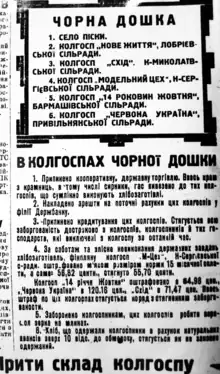Blacklisting (Soviet policy)
Blacklisting,[1] or the system of the chorna doshka (Ukrainian: чорна дошка, lit. 'black board') synonymous with a "board of infamy", was one of the elements of agitation-propaganda in the Soviet Union, and especially Ukraine and the ethnically Ukrainian Kuban region in the 1930s, coinciding with the Holodomor. Blacklisting was also used in Soviet Kazakhstan.[2]

| Part of a series on the |
| Holodomor |
|---|
A blacklisted collective farm, village, or raion (district) had its monetary loans and grain advances called in, stores closed, grain supplies, livestock, and food confiscated as a "penalty", and was cut off from trade. Its Communist Party and collective farm committees were purged and subject to arrest, and their territory was forcibly cordoned off by the OGPU secret police.[1] Although nominally targeting collective farms failing to meet grain quotas and independent farmers with outstanding tax-in-kind, in practice the punishment was applied to all residents of affected villages and raions, including teachers, tradespeople, and children.[1]
The blacklist system was formalized in 1932 by the November 20 decree "The Struggle against Kurkul Influence in Collective Farms",[1] and supplemented in January 1933 by Stalin's "Preventing the Mass Exodus of Peasants who are Starving," banning travel by peasants from affected regions in Ukraine and the Kuban. The blacklist policy was part of the collectivization process and the fight with kulaks (kurkuls). The "black boards" were installed at entrances to a settlement and identified the residents that were accused of counter-revolutionary activity and who were labelled enemies of the people, allegedly trying to undermine the process of collectivization. The fact of nominating of such settlements was published in the oblast newspapers listing the names of collective farms that resisted collectivization and the Soviet regime.
However some of the archives reflect that "black boards" were used precisely as a repressive element in the fight not only against the collectivization resistance, but also against the nationality factor of the local population. For example, in 1932 the Vinnytsia Oblast Communist Party Committee suggested the local village of Mazurivka to be nominated to "black boards", because there was born one of Symon Petliura's generals Khmara, while the village of Karpivtsi (Chudniv Raion) in Volyn was known as one of the Petliura's. The village of Turbiv (Lypovets Raion), for example, deserved such a penalty for its "high infestation of the Petlyura element and participation in the Plyskiv affair in spring". Each settlement or an administrative unit with black boards was encircled by armed squads and was subjected to complete food requisitioning.
In the end 37 out of 392 districts[3] along with at least 400 collective farms where put on the "black board" in Ukraine, more than half of the blacklisted farms being in Dnipropetrovsk Oblast alone.[4] Every single raion in Dnipropetrovsk had at least one blacklisted village, and in Vinnytsia oblast five entire raions were blacklisted.[1] This oblast is situated right in the middle of traditional lands of the Zaporizhian Cossacks. Cossack villages were also blacklisted in the Volga and Kuban regions of Russia.[1] In 1932, 32 (out of less than 200) districts in Kazakhstan that did not meet grain production quotas were blacklisted.[2] Some blacklisted areas[3] in Kharkiv could have death rates exceeding 40%[5] while in other areas such as Vinnytsia blacklisting had no particular effect on mortality.[5] The only blacklisted district in the Stalino oblast[3] had a mortality rate that was roughly 2 to 3 times higher than most of the oblast with only 2 districts in the oblast having a comparable death rate.[5]
Notes
- Andriewsky, Olga (2015-01-23). "Towards a Decentred History: The Study of the Holodomor and Ukrainian Historiography". East/West: Journal of Ukrainian Studies. 2 (1): 18–52. doi:10.21226/T2301N.
- Environment, Empire, and the Great Famine in Stalin's Kazakhstan Niccolò Pianciola
- "Blacklisted Localities (Gallery)". gis.huri.harvard.edu. Retrieved Oct 23, 2022.
- Papakin, Heorhii (2010-11-27). ""Chorni doshky" Holodomoru – ekonomichnyi metod znyshchennia hromadian URSR (SPYSOK)" ["Black boards" of the Holodomor: An economic method for the destruction of community members of the Ukrainian SSR (list)]. Istorychna Pravda (in Ukrainian). Archived from the original on 2019-01-03. Retrieved 2021-01-25.
- "Population Losses (Gallery)". gis.huri.harvard.edu. Retrieved Oct 23, 2022.
References
- Pyrih, P., ed. (2007). "Postanova Politbiuro TsK KP(b)U pro zakhody z posylennia khlibozahotivelʹ vid 18.11.1932 r." Постанова Політбюро ЦК КП(б)У про заходи з посилення хлібозаготівель від 18.11.1932 р.. Holodomor 1932–1933 rokiv v Ukraïni: Dokumenty i materialy Голодомор 1932-1933 років в Україні: Документи і матеріали (in Ukrainian). Kyïv: VD Kyievo-Mohyliansʹka akademiia.
- "Arkush 532". Fond 806, Box: opys 1, File: sprava 22. Central State Archives of Supreme Bodies of Power and Government of Ukraine.
- Vasylʹiev, V.; Shapoval, Yu., eds. (2001). Komandyry velykoho holodu: Poïzdka V. Molotova ta L. Kahanovycha v Ukraïnu ta na Pivnichnyi Kavkaz. 1932–1933 r. Командири великого голоду: Поїздка В. Молотова та Л. Кагановича в Україну та на Північний Кавказ. 1932-1933 рр. (in Ukrainian). Kyïv: Heneza.
- Pyrih, P., ed. (2007). "Postanova TsK KP(b)U ta RNK USRR pro zniattia z "chornoï doshky" s. Kamiani Potoky Kremenchutskoho raionu Kharkivsʹkoï oblasti, 17.10.1933" Постанова ЦК КП(б)У та РНК УСРР про зняття з "чорної дошки" с. Кам'яні Потоки Кременчуцького району Харківської області, 17.10.1933. Holodomor 1932–1933 rokiv v Ukraïni: Dokumenty i materialy Голодомор 1932-1933 років в Україні: Документи і матеріали (in Ukrainian). Kyïv: VD Kyievo-Mohyliansʹka akademiia.
- Pokydchenko, L. A., ed. (2006). Holodomor 1932–1933 rokiv na Sumshchyni Голодомор 1932-1933 років на Сумщині (in Ukrainian). Sumy: Iaroslavna.
- Spokuta: Holodomory na Zaporizhzhi (1921–1922, 1932–1933, 1946–1947 rr.): Statti, dokumenty, spohady Спокута: Голодомори на Запоріжжі (1921-1922, 1932-1933, 1946-1947 рр.) / Статті, документи, спогади (in Ukrainian). Zaporizhzhia: Dniprovsʹkyi metalurh. 2008.
Further reading
- Papakin, Heorhii (2009). ""Blacklists" as a Tool of the Soviet Genocide in Ukraine" (PDF). Holodomor Studies. Vol. 1, no. 1 (Winter–Spring 2009). Translated by Marta D. Olynyk. pp. 55–75. Retrieved 2021-01-25.